Sometimes the steps involved in a failed attempt on prey are as much fun to watch as success.
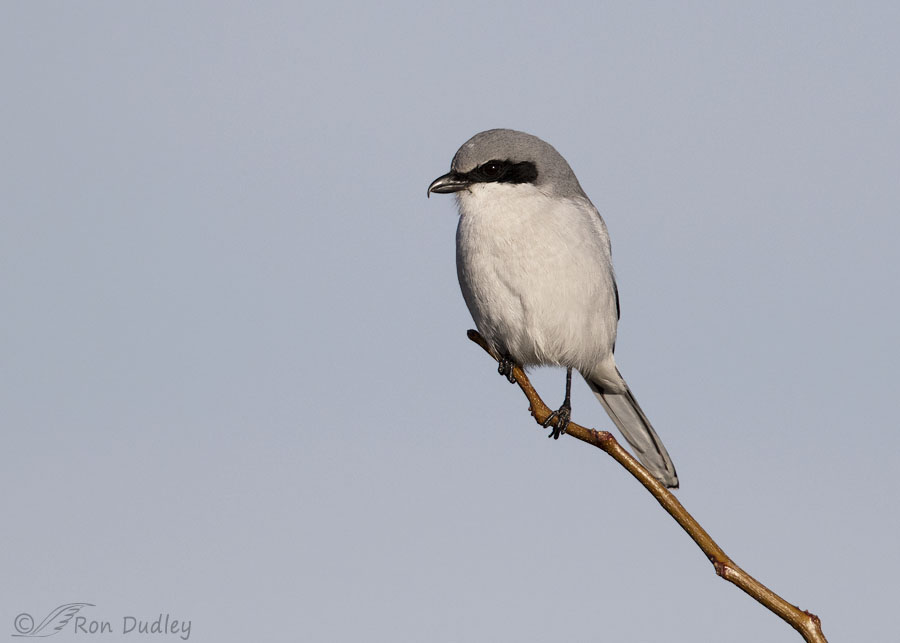
1/6400, F/6.3, ISO 400, Canon 7D Mark II, Canon EF 500mm f/4L IS II USM + EF 1.4 III Extender, not baited, set up or called in
Yesterday morning this Loggerhead Shrike was obviously hunting from this twig atop a small bush in Box Elder County. I had to do some creative maneuvering with my pickup to get close enough for quality photos and usually that would spook a shrike but ‘he’ was so intent on his hunting he didn’t fly off.
I knew the plain sky background would be kind of boring so typical of me I was after takeoff and flight shots, even though I knew my chances were slim because shrikes take off so fast and without warning.
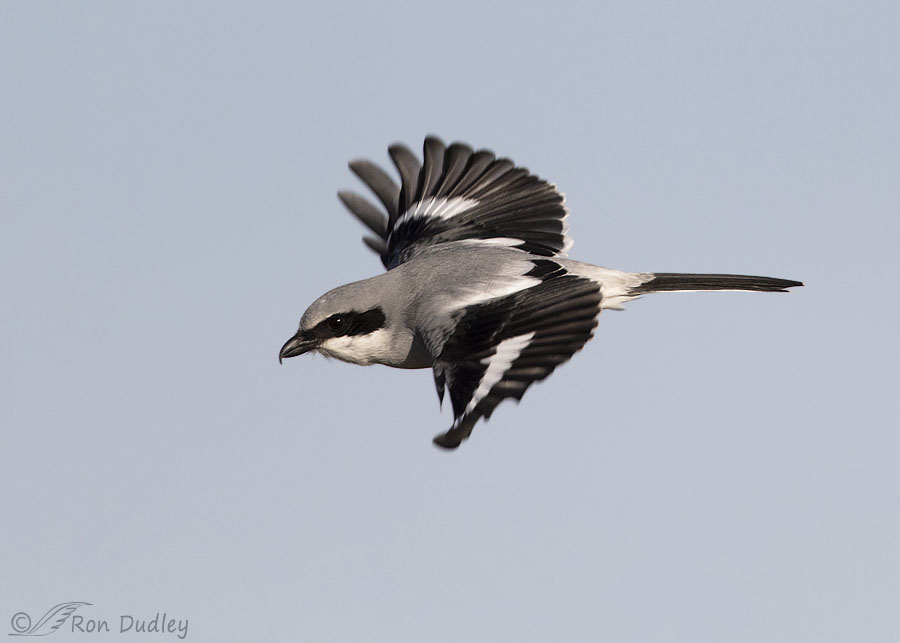
1/5000, F/6.3, ISO 400, Canon 7D Mark II, Canon EF 500mm f/4L IS II USM + EF 1.4 III Extender, canvas added, not baited, set up or called in
When he launched after prey I got him but I didn’t get him very sharp. And he was so close to the frame edge I had to add canvas for composition. Normally I wouldn’t post a photo this soft but I decided to include it to help me tell the story.
He disappeared in the vegetation below and in front of him so I didn’t know if he caught anything. Soon he flew back to the same bush he’d launched from but…
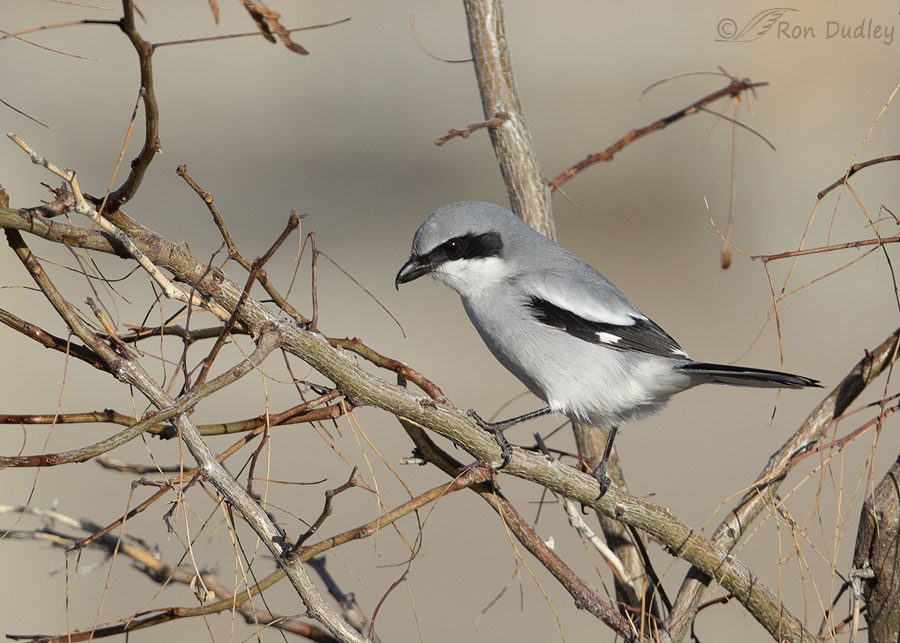
1/2500, F/6.3, ISO 400, Canon 7D Mark II, Canon EF 500mm f/4L IS II USM + EF 1.4 III Extender, not baited, set up or called in
this time he landed near its base. He didn’t have prey with him (he may or may not have gulped it down while he was on the ground) but he was far enough away that at the time I couldn’t tell for sure if he had prey or not.
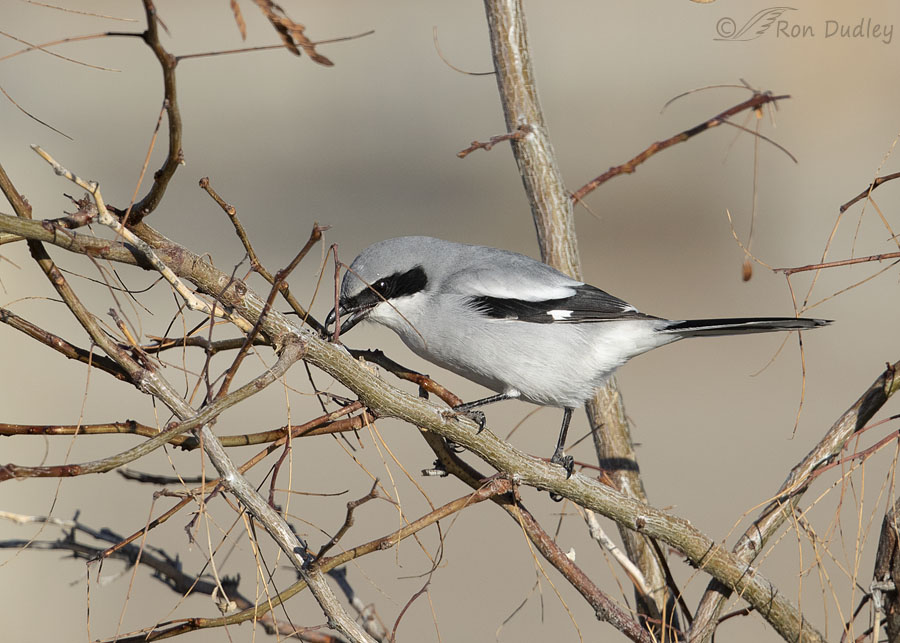
1/2000, F/6.3, ISO 400, Canon 7D Mark II, Canon EF 500mm f/4L IS II USM + EF 1.4 III Extender, not baited, set up or called in
Through my lens it looked to me like he was impaling prey (likely an insect) on a projection of one of the twigs but I was mistaken. Then I thought he might be cleaning his beak but after looking at my photos I don’t think so.
To be honest I’m not sure what he was doing but whatever it was he spent considerable time doing it (I have many photos documenting the behavior that I don’t quite understand).
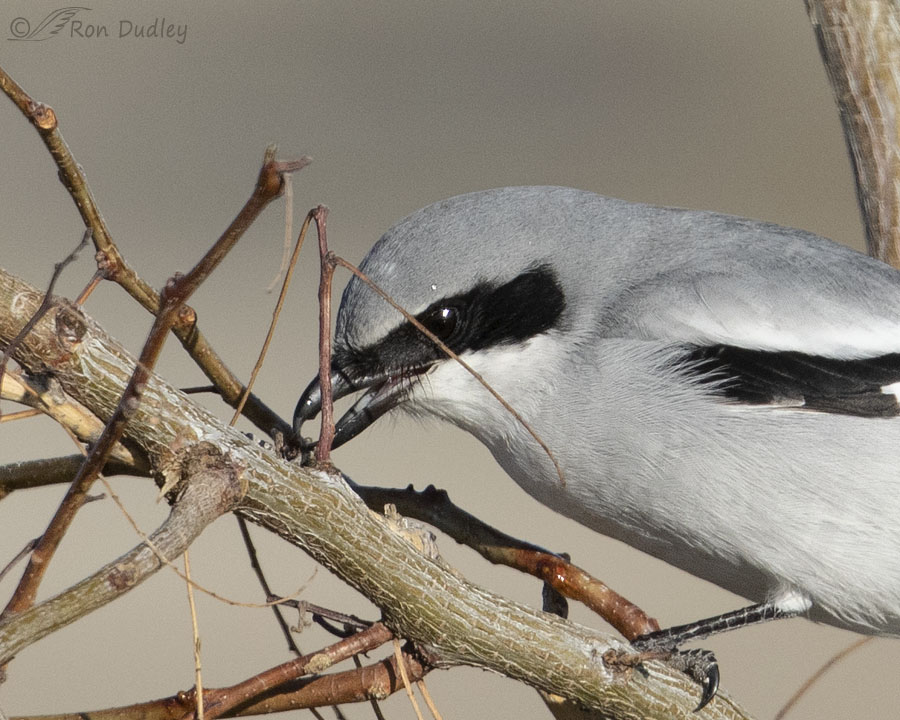
1/6400, F/6.3, ISO 400, Canon 7D Mark II, Canon EF 500mm f/4L IS II USM + EF 1.4 III Extender, not baited, set up or called in
A very large crop of the previous image allows the tomial tooth (falcon tooth) on the upper mandible to be seen a little better. Shrikes use that projection to kill their prey more efficiently. Here’s what Cornell has to say about shrikes and the tomial tooth when it’s used on vertebrate prey such as small mammals, other birds or lizards.
“kills its vertebrate prey by precisely attacking the nape and then severing the cerebral vertebrae in a series of grabs and bites. Tomial tooth in upper mandible probably serves as a device for penetrating quickly to the spinal cord through the space between the articulating vertebrae, thereby damaging the cord, producing partial paralysis, and rendering the quarry easier to kill.”
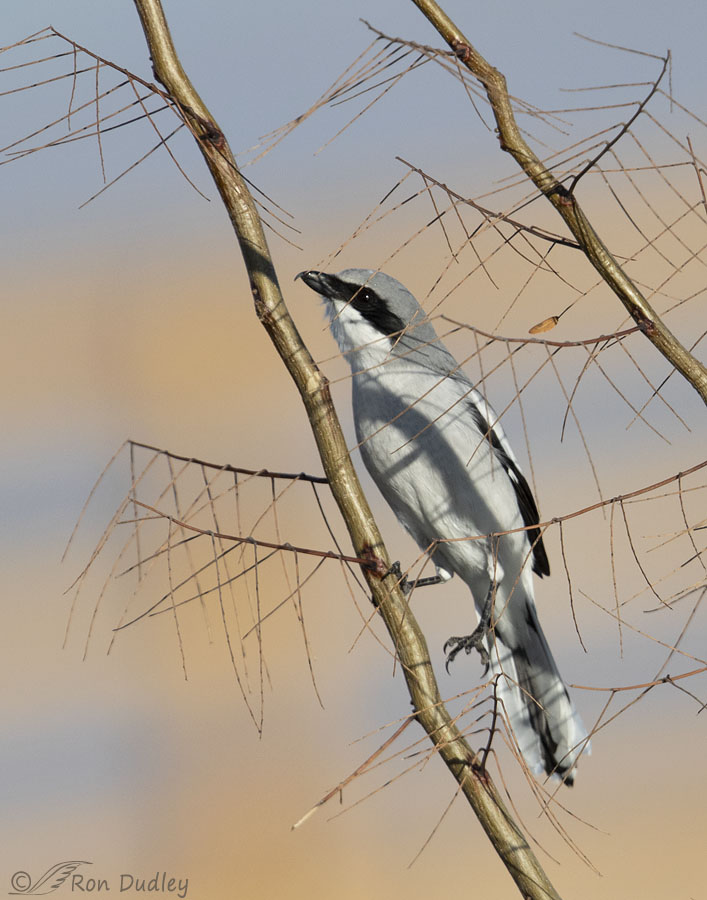
1/3200, F/6.3, ISO 400, Canon 7D Mark II, Canon EF 500mm f/4L IS II USM + EF 1.4 III Extender, not baited, set up or called in
Then he surprised me by scampering (running, actually) straight up one of the nearly vertical branches of the bush.
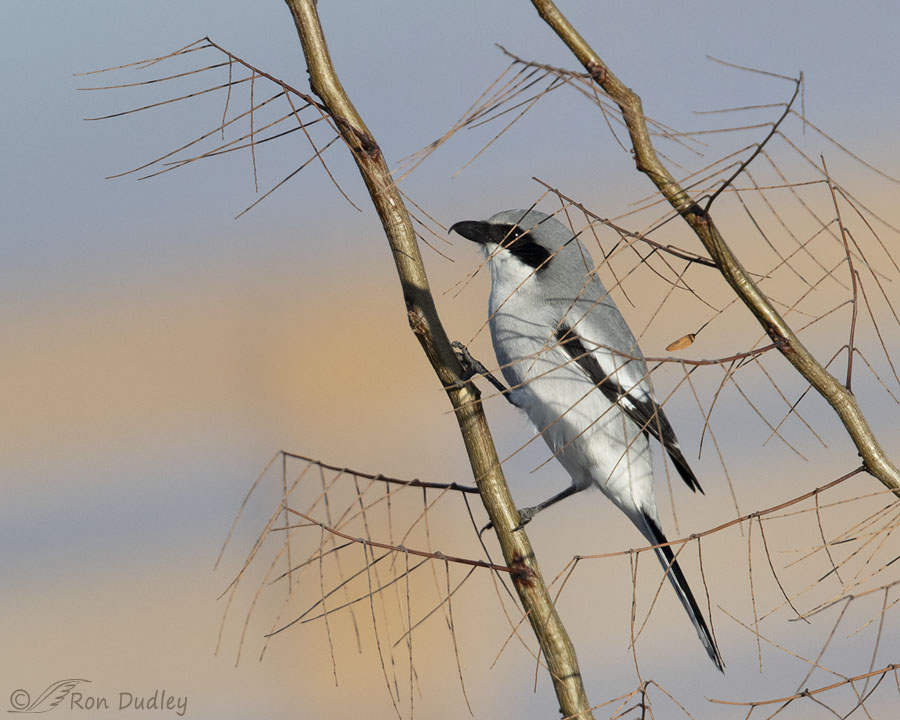
1/3200, F/6.3, ISO 400, Canon 7D Mark II, Canon EF 500mm f/4L IS II USM + EF 1.4 III Extender, not baited, set up or called in
He obviously had a destination in mind.
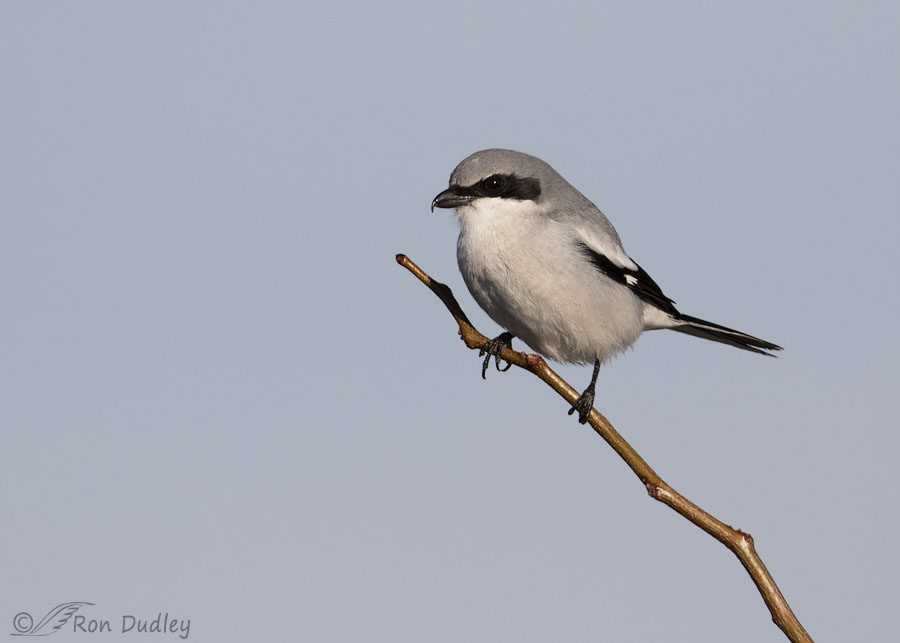
1/4000, F/6.3, ISO 400, Canon 7D Mark II, Canon EF 500mm f/4L IS II USM + EF 1.4 III Extender, not baited, set up or called in
He ended up right where he’d started and began hunting again. But he didn’t hunt for long before he flew off.
I was delighted more than usual to photograph several interesting birds yesterday, including this shrike, because it doesn’t look like I’ll be able to go out shooting again for a few days. We have a storm moving in that’s ‘supposed’ to dump 4-8″ of snow in the valleys and up to 2′ in the mountains over two days. On the remote possibility that the forecasters are right I moved my snow blower to my garage from storage in my shed yesterday afternoon.
I’ll believe it when I see it. And maybe not even then.
Ron


Great series, Ron. Wonderful, sharp photos.
Thanks, Nancy. ” Sharp” except for the second one… 🙂
Could your shrike have been picking at a spot where it had left prey before? Looking (hoping?) for leftovers? When I don’t feel like a run to the store I always check the fridge first…
I wondered about that, Jim. I couldn’t see anything like that in the photo but just because I didn’t see it doesn’t mean it wasn’t there.
Nice series, I miss the one we had in the gully when I first moved in 1986. Guardsman’s Way use to be open fields along with Mt Olivet cemetery the area was great bird habitat. Cemetery still has wildlife but less.
Seems like everywhere has less wildlife…
Ron, great series on the Shrike!
You shall soon believe the snow. It started a half hour ago here in N. Nevada (Carson Valley area) and it’s coming down good. This, after an Aug-Nov.stint that was so bone-dry we thought we would never see moisture again!
Thanks, David. I hope you’re right. So far it’s barely coming down and barely sticking on the grass. Melting everywhere else.
You’re getting snow, we’re getting a drizzle (so far) of rain … I’ll take any and all of it, even at the sacrifice of no FP for a day or two.
In the meantime, there’s this handsome bandit bird to enjoy … I really like that shot of him clambering up the branch, with all those spiky twigs surrounding him (a catchlight in the eye) and the colorful sky behind him.
Thanks, Chris. So far our snow is nothing serious but that could change. Or not…
Perhaps he is picking at bugs, honing his hook, or just messin’ around. The flight shot is reminiscent of your famous Magpie photo.
Snowblower: sold mine when we moved here. Don’t miss it one bit. And really don’t miss the snow plow piling ice boulders in the driveway. 😀
Lyle, he may have been picking at bugs but he didn’t seem to be either honing or cleaning his beak.
Great shots Ron – especially like the soft flight shot just to see the wing pattern which is quite interesting! Fingers crossed you get a lot of snow!
Thank you, Kathleen. It’s begun…
Yet another fascinating series. The sixth and seventh photos made me think of viewing this feisty little hunter through spider webs.
Lots of snow? I feel for you but hope it brings much needed water to your area. As I type it is raining here. We have had a very wet spring. Summer is predicted to be more of the same. And I much prefer it to the alternative.
EC, it finally started to snow lightly a short while ago. It had to get down to 35° before the rain switched over to snow.
I’m delighted that you’re in a wet spell. After the last couple of years you have it coming.
The simplicity of the first shot allows us to observe just how large a head
this little “bandit” has in proportion to the rest of the body– probably needs
it, given “his” prey—the twigs in several of the final shots–most unusual
ones –made him appear to be perching inside a harp– and he could certainly play one with that tomial tooth…. fiercely beautiful !
“allows us to observe just how large a head this little “bandit” has”
Good observation, Kris. That’s where the “loggerhead” part of their name comes from.
Very interesting and educational narrative. As I have acknowledged previously I learned from you that Shrikes are hunter/killers. I had been taking photos of them for a few years and had no idea they were. All the photos I had taken were of them just quietly perched.
I like that takeoff photo even with the soft wingtips.
I think we are supposed to get at least some of that storm.
Thanks, Everett. I hope you get some of it. I imagine you need the moisture as much as we do.
Once again the narrative makes the shots come alive. Makes me almost feel that I was right there. (And who says that background is boring? Just me, maybe, but I love it.)
Much appreciated, Granny Pat. Glad you enjoyed the narrative too.
Interesting capture of the puzzle of the Shrike behavior. 🙂 Just don’t know more often than we realize! 😉 The ARE pretty little birds tho the tomial tooth DOES indicate one probably doesn’t want to grab one……
The 4 or so inches of “dry” snow we got promptly vanished yesterday with the warmth (made 50) and wind to match here. Creek still running well however so won’t whine TOO much.. 😉
“the tomial tooth DOES indicate one probably doesn’t want to grab one”
Judy, I’ve seen researchers using gloves when handling shrikes. For good reason…